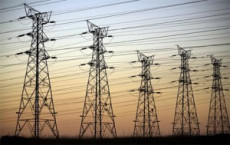Berkeley Lab Researchers Receive Recovery Act Funds to Help Improve Reliability of Electrical Grid
September 1, 2009
Contact: Linda Vu, CSnews@lbl.gov
BERKELEY, CA– The Lawrence Berkeley National Laboratory (Berkely Lab) announced today that mathematicians from its Computational Research Division (CRD) are receiving Recovery Act funds to help increase the reliability of the electrical grid and improve the nation's ability to respond to energy disruptions. By advancing the technologies needed to implement a smart grid, Berkeley researchers will play an important role in avoiding costly, cascading blackouts like the August 2003 blackout that affected eight northeastern U.S states and Canada.
Although improvements to the nation's power grid have since been put in place, further research is needed to expand the grid's ability to simultaneously respond to multiple power outages and automatically re-route electricity to avoid broader blackouts.The CRD researchers will receive $875,000 in Recovery Act funding from the Office of Advanced Scientific Computing Research within the DOE Office of Science to help develop Smart Grid technologies.
The three-year project, in which Berkeley Lab researchers will collaborate with mathematicians and power engineers from Cornell University and the University of Wisconsin, will develop optimization algorithms that detect vulnerabilities in the power-grid, analyze cascading outages and perform resource allocation across multiple locations and times.
"The North American power grids combine to make one of the largest interconnected systems on earth. It has a complex transmission network, containing more than 9,200 electric generating units connected to over 200,000 miles of transmission lines," says Juan Meza, head of the High Performance Computing Research Department and Lead Principal Investigator for the project.
Identifying Weaknesses in the Grid
Electricity is distributed across North America on multifaceted grids, which are controlled by a variety of players. These large interconnects are divided amongst a number of regional utility companies which are responsible for maintaining their portion of the grid and delivering power to consumers.
Because electricity cannot be stored, the electric power system must constantly be adjusted to ensure that the generation of power matches the demand. This task falls on hundreds of Control Area Operators across the continent using computerized control centers. The regional utility companies are responsible for coordinating the area operators working on their portion of the grid.
"Although interconnectedness ensures that the system is reliable most of the time, it also means that a few critical line failures could potentially cause a massive blackout," says Meza.
The grid delivers electricity from power plants to consumers via two primary systems, the transmission system and the distribution system. First, the transmission system transports electricity from power plants to substations near populated areas; then the distribution system delivers electricity from substations to consumers' homes and businesses. If each power plant, substation and consumer is represented as a point on the electric power grid, then multiple redundant lines connect each point to ensure that power can travel a variety of routes, from any power plant to any substation and consumer. This means that a line failure between any of these points will not cause a power outage for consumers because power can be rerouted.
The problem becomes even more complex because not all transmission lines on the grid are created equal. Some lines and routes are created to carry more power than others, and options for how to reroute power could affect the severity of an outage—will it affect a neighborhood or an entire city?
Finding the best "detour"
Meza notes that one current approach for determining the optimal "detour" routes in the event of a transmission line failure is to build a large-scale model of the grid and test different scenarios to determine which will cause a blackout. Although this approach has worked so far, experts warn that it will soon be impractical as the demand for power grows and the grid becomes ever more complex.
Instead of building a model of the entire electric power grid, Meza and his collaborators will use combinatorial techniques and graph algorithms to identify all the critical line failure scenarios that could lead to a blackout. He notes that by taking advantage of these mathematical methods the computational cost is drastically reduced, and the methods can easily be modified to detect vulnerabilities in the grid as it becomes more complex.
Their mathematical methods will also identify optimal detours for rerouting power in the event of multiple line failures and rank the solutions from those that will cause minor outages to those leading to severe blackouts. This will help facilitate decision making between the many players involved in both the long- and short-term process of delivering electricity.
"Our combinatorial techniques can analyze vulnerabilities of large complex systems in a fraction of the time needed by previous methods. This vulnerability analysis will be an important component in decision support and policy making, thereby providing a more reliable and efficient power grid," says Meza.
About Computing Sciences at Berkeley Lab
High performance computing plays a critical role in scientific discovery. Researchers increasingly rely on advances in computer science, mathematics, computational science, data science, and large-scale computing and networking to increase our understanding of ourselves, our planet, and our universe. Berkeley Lab’s Computing Sciences Area researches, develops, and deploys new foundations, tools, and technologies to meet these needs and to advance research across a broad range of scientific disciplines.







 Instagram
Instagram YouTube
YouTube